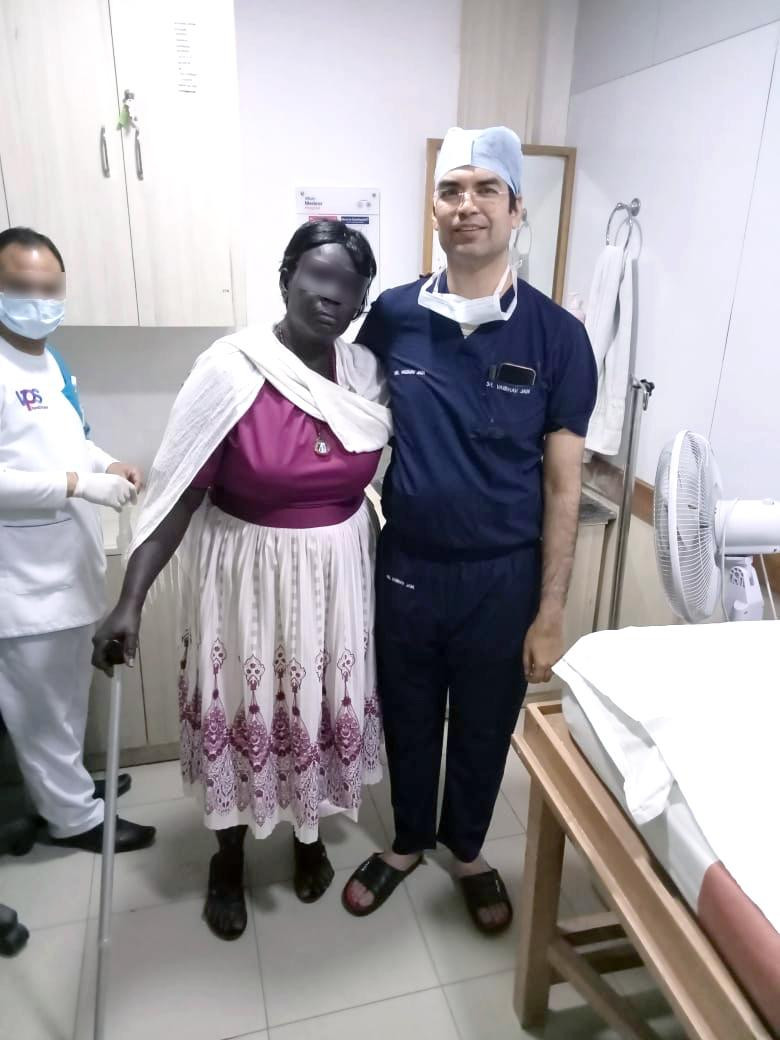WHAT IS KNEE REPLACEMENT SURGERY? BEST KNEE REPLACEMENT SURGERY IN NOIDA – DR VAIBHAV JAIN
Knee replacement surgery in Noida and Delhi, also known as total knee replacement arthroplasty, is a surgical procedure in which surgeons replace the damaged surfaces of the bones that make up the knee joint with artificial material or implant.
In a total knee replacement, only the damaged area of the bone is cut out, and prosthetic pieces or implants are put to cap the ends of the bones instead of actually removing and replacing the bone that makes up the joint. The phrase "knee resurfacing procedure" is preferable. Patients with osteoarthritis have this surgery to relieve joint discomfort and impairment. In cases of injury, trauma, or arthritis, it can also help the knee function better.
Partial knee replacement is yet another type of knee replacement surgery. A partially injured knee undergoes rigid partial knee replacement surgery. It is just as effective as total knee replacement surgery while being less intrusive.
WHO CAN SUFFER FROM KNEE PAIN?
In general, women, men, children, and old individuals can all have knee discomfort at any time. In older people, this ailment is a little more problematic. Knees are the name for the joints that form between the legs. The knees are used for a variety of tasks, including getting up and moving around to walking. The person's everyday routine changes when there is discomfort in these joints. There are numerous causes for this pain, which may only last a short while or may continue to bother you for the rest of your life. Going to work in the morning and then sitting at your desk and enjoying breakfast, tea, and lunch because of the growing workload each day,
In general, women, men, children, and old individuals can all have knee discomfort at any time. In older people, this ailment is a little more problematic. Knees are the name for the joints that form between the legs. The knees are used for a variety of tasks, including getting up and moving around to walking. The person's everyday routine changes when there is discomfort in these joints. There are numerous causes for this pain, which may only last a short while or may continue to bother you for the rest of your life. Going to work in the morning and then sitting at your desk and enjoying breakfast, tea, and lunch because of the growing workload each day,
Dr Vaibhav Jain will decide after a proper examination whether you are fit for this surgery or not.
Patients who are suggested not to have knee replacement surgery are
- Patients have difficulty extending their knees. E.g. when we stand from a sitting position, the knee extends
- Patients with sepsis (infection)
- Patients under 50 years of age (although patients who may still undergo knee replacement if they are in severe pain and have tried and exhausted all other treatment options)
- Very fat people
- A physically demanding profession involves daily high-impact activity, where the results of surgery may not be long-lasting
3. PREPARING BEFORE KNEE REPLACEMENT?
Before knee replacement surgery, Dr Vaibhav Jain may do some tests to diagnose problems with your joints.
- Physical examination – The patient is examined in a lying position. The doctor then looks for signs of joint inflammation, joint deformity, and muscle damage. The doctor then feels the joint to check for warmth, swelling, fluid, and tenderness of the joint. In addition, doctors check the range of motion of the joint by rotating the knee back and forth to check for any stiffness of the joint.
- Blood tests – Special blood tests may be done to check the level of inflammation or the presence of antibodies. For example, the presence of rheumatoid factor (RF) in the blood may indicate the presence of autoimmune disease, particularly rheumatoid arthritis. Common blood tests like CBC, blood glucose, kidney function test, and liver function test are done beforehand.
- Joint aspiration – In this procedure, a small sample of fluid is collected from the knee joint using a needle and sent for further examination. This is done in selected patients only when needed.
- Imaging tests – The most commonly used imaging tests are X-rays as they help to see structural changes, signs of joint wear, loss of cartilage or tissue tearing, swelling, amount of fluid present, etc. Sometimes an MRI or CT scan is planned to obtain further information.
4. HOW IS KNEE REPLACEMENT DONE?
Knee replacement surgery is performed under spinal or general anaesthesia.
- During knee replacement surgery, a cut is made on the skin at the front of the knee to access the kneecap (patella). The patella is then rotated outwards to get a better view of the area that needs repair.
- The femur, the lower end of the thigh bone, is then measured and brought back to the front. The damaged portion of bone and cartilage is cut from the lower end of the femur using special instruments and then fitted to the metal femoral component of the prosthetic knee.
- After, the tibia (shin bone) is regenerated by removing the damaged bone and cartilage from the upper end of the tibia and then reshaped to fit the plastic or metal tibial component.
- The patella is re-adjusted. The damaged part of the patella is repositioned and fitted with a patellar button, or the patella is reshaped. The surgeon adds a plastic spacer between the femoral and tibial components to avoid friction between the prostheses.
- The prosthesis is usually attached to the bone by surgical cement and is known as a cemented prosthesis.
- The function of the replacement is checked by bending the knee and the incision is closed with sutures or surgical staples.
- Knee replacement surgery in the right way can provide your knee with function for about 10 to 15 years.




Comments
Post a Comment